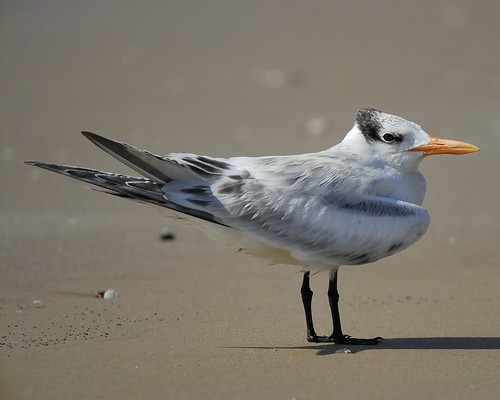tags: Royal Tern, Sterna maxima, birds, nature, Image of the Day
[Mystery bird] Royal Tern, Sterna maxima, photographed at Quintana and Bryan Beaches, Texas. [I will identify this bird for you tomorrow]
Image: Joseph Kennedy, 3 September 2008 [larger view].
Nikon D200, Kowa 883 telescope TSN-PZ camera eyepiece 1/2000s f/8.0 at 1000.0mm iso400.
Rick Wright, Managing Director of WINGS Birding Tours Worldwide, writes:
Bring that recent ruffian of a Caspian Tern back up on your screen, and turn everything we said about that bird into its opposite. Here's a slender, graceful-footed, pale-headed bird, far less threatening in every way than its larger, meaner cousin. The stout, pale-tipped bill, the short haircut, and the pale upperparts make this one another Royal Tern. Elegant Tern would have a longer, finer bill, with a much less prominent gonydeal angle and a longer crest.
This individual is a juvenile molting into first-winter plumage, still showing dark-centered tertials and a dark carpal bar.
- Log in to post comments


YA Royal Tern, yes? But this one looks a little unhappy. Or maybe pessimistic. A tern for the worst, perhaps.
Royal tern.
Royal Tern, indeed
Another vote for Royal Tern
Elegant Tern
I'll say royal tern for this bird too.
Royal Tern (age?)
I guess you can't have enough field guides - this bird has both juvenile and non-breeding adult features as shown in Sibley. Juvenile: Yellowish bill, mottled coloring on the proximal wing feathers and black centers on the lower back feathers. Non-breeding: Black legs and a military style hair cut.
Well I just bought The Shorebird Guide so I think I would prefer a free primer on how bird coloring tends to change with age. As an example, does foot and bill color change quickly or slowly, in or out of sync with the feathers and is the molt sudden or prolonged. Anyone. Anyone.
Oh yes, add that the juvenile in Sybley has yellow legs.